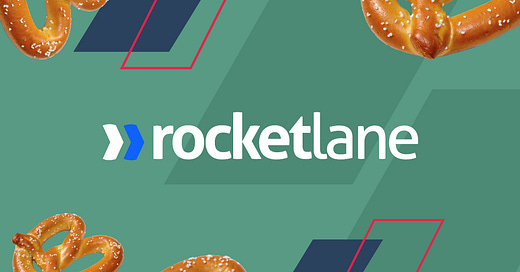How Rocketlane built a marketing machine before it had a product
The second part of a series on India's super cool startups
When I was in Pune last monsoon, a friend from Freshworks called me on after reading this. A sharp-as-nails product thinker, he had just started up on his own, and was figuring out a lot of early stage stuff.
He wanted to know when he should be starting marketing.
My answer to him, and this is something I’ve written about repeatedly in this newsletter, was that the best time to start was two months ago, and the second best time is now.
I’ll explain.
Consider this: You are building a ground-breaking product in stealth. Takes a year, but you are done. You’ve put out a kick-ass MVP, and it’s ready to go. You do all the things everyone tells you to: launch blog, product hunt, reach-outs, even start running ads.
Except nothing happens.
What did you expect?
No one knows who or what you are. How will the world be excited about what you have built? You are just starting to tell them now, and believe it or not, the world is not waiting for the next B2B SaaS product. They have other stuff to do.
So you double down on ads, the easiest way to quickly acquire a few early customers. But again, there’s a snag: Paid acquisition is now as expensive as it has ever been, and you just can‘t sustain the spend, especially because you are starting to think about marketing only now. You barely know how to tell your startup story, let alone have landing pages.
So you are now stuck until you get your marketing sorted.
Now consider this: What if you invest in marketing and branding as you start building your product? If you know who you are building it for, as you probably do, you can actually start marketing to them and branding yourself on those lines.
You are now immediately at an advantage when it comes to demand generation and acquisition. Starting early also gives you a chance to build yourself distribution channels and waiting lists, which means that your first customers can already be waiting for you.
Now which of these two do you want to be?
Most startups don’t think about this, though. Simply because the investment in marketing and branding is not seen as justified this early by founders who tend mostly to be PMs and engineers. Their thinking is this: Why waste time and resources on marketing now, let’s get the MVP out, then start putting ourselves out there, and acquire customers.
Problem is, those days are over.
If you are not investing in brand and content early, you are going to be on the back-foot after you launch. The investment you did not make early will now have to be made in multiples. And it will cost money and expensive talent.
Not a situation you want to be in.
I’ll tell you which startup is not in that situation: Srikrishnan Ganesan’s Rocketlane.
Rocketlane is a customer onboarding platform that announced its seed funding last month, and launched their product. Srikrishnan Ganesan, co-founder and CEO, is a second time entrepreneur, having sold his first startup Konotor in 2015 to Freshworks. His co-founders Vignesh Girishankar and Deepak Bala are close partners-in-crime.
When I was speaking to him about something else this year, a line he said stuck in my head: "I’m okay with mistakes, I just don’t want to make the same mistakes again."
Srikrishnan knew he was building a new category, and he knew that brand and content were critical, so he started reading books on category creation. One of them (Anthony Kenneda’s Category Creation) suggested writing down all the topics you'd want to cover as chapters if you were writing a book about the category. And then crafting blogs around those topics.
So he took time off and did that. He creating a list of topics related to the category and then started writing about them. He also started making notes on interesting stories that the team could tell about the product and the customer. This also included their own challenges and successes inside Rocketlane. The intent was to turn everything interesting and useful into content.
Some of this writing morphed into the first blogs for Rocketlane, especially the ones about the category, and the posts which detailed the narrative of the startup.
As they launched the website, they already had close to a dozen blogs on it. If someone wanted to know what Rocketlane was about, everything they needed to read and understand was already there.
In September last year, they started their community initiatives. They started with a single digit audience. The team started an event called Implementation Stories that interviewed professionals and dove deep into their experiences. This was useful to attract the audience Rocketlane wanted, and the community swelled.
It was so successful that they made this into an ongoing webinar series that has now been running for close to a year.


Late last year, they started their podcast, The Launch Station, season 1 of which they’ve just gotten done with, with 13 episodes they have launched as audio and on YouTube.
The podcast and the guests they had on, attracted again the audience they wanted, helped them gain credibility and warm intros into the organisations their guests came from. This meant more people now knew the brand and wanted to try the product for themselves.
The second season is on the way, I’ve been told.
Of course it is.
As their marketing flywheel started working, with their blogs, webinars, podcasts, and community initiatives combining to give them some great audience and word of mouth, they doubled down. Events became regular, the podcast became something everyone got involved in, and the community got a dedicated manager. Rocketlane made sure their audience got value out of what they were creating, and the brand became popular.
Lest you forget, all of this was done before the product launched.
And you know what all of this did for Rocketlane? As Srikrishnan told me, folks assumed that Rocketlane had been around for a few years and was a much bigger company.
Which meant they didn't have as much of an uphill battle on brand and credibility while up against bigger players, and could now fight just on the merit of their product. (And of course they'd done a brilliant job executing on product!)
Isn’t that exactly the problem that startups are usually faced with after launch? No one knows them, and therefore even with a great product and clear positioning, cracking deals and reaching PMF becomes difficult.
Not for Rocketlane. They did all of that before getting to market.
Two things jump out at me from this story:
One is that as a startup, you need to create. Blogs, podcasts, videos, webinars - you need to produce, create, publish. Measurement can come later, you need to get things out there to get clarity for yourself and to quickly get feedback. Rocketlane understand this.
The second is that you need extreme clarity about your user/buyer persona. Only then can you create targeted, useful, educational, and aspirational content that attracts who you want to attract. Rocketlane have this, and this is why they could get their marketing up and running so quickly.
One final question I asked Srikrishnan was why he made marketing at this scale such a priority at an early stage, and how he knew he had to do all of this.
His answer was short: Experience. He had built and run 3 products, and by now he had understood that great products with average marketing can be very tough grinds indeed. Rocketlane knew they could build a great product, and had made up their mind that they weren’t going to let average marketing let it down.
Srikrishnan definitely isn’t making that mistake again.
A reminder that this is the second of a month-long series on super cool startups.
You can read the introductory essay here.
The first dispatch of the series is on how CRED is building a brand that’s impossible to ignore. The third, which I’m working on, is on early stage PR.
Subscribe below to get these directly in your inbox.



